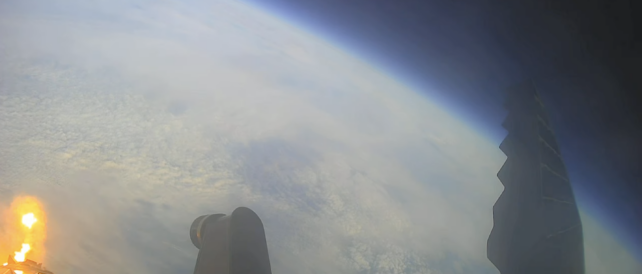SpaceX carried out Starship's first test flight on Thursday morning – successfully launching the shiny silver mega-rocket that could one day take humans to Mars and beyond.
Around 4 minutes after take off, the rocket blew up – or experienced a 'rapid unscheduled disassembly' – as the team attempted stage separation.
But the fact the rocket cleared the launchpad and flew for 4 minutes is an incredible feat for a first test flight, and it's an exciting first step for the rocket.
Congratulations to the entire SpaceX team on an exciting first integrated flight test of Starship!
— SpaceX (@SpaceX) April 20, 2023
Here's the incredible view from the onboard camera as Starship blasted away from Earth.

When the team tried to separate the stage one Starship rocket from the Super Heavy booster below, the spacecraft started to spin and lost control before blowing up.
Here's the moment the spacecraft fell apart.

You can watch the whole thing as it happened in the replay of the live stream below.

This was the second test flight attempt; the first try on Monday was turned into a wet dress rehearsal around 10 minutes before liftoff due to pressurization issues.
The team troubleshot those issues during the week and recycled the fuel from the initial launch attempt.
Liftoff of Starship! pic.twitter.com/4t8mRP37Gp
— SpaceX (@SpaceX) April 20, 2023
Musk tweeted that the SpaceX team learned a lot from the frozen pressurant valve.
All systems currently green for launch https://t.co/VxZOEaD652
— Elon Musk (@elonmusk) April 20, 2023
Starship is 40 stories tall. It consists of the spacecraft – a 50-meter (164-foot) reusable crew and cargo capsule – stacked on top of a 70-meter (230-foot) tall Super Heavy rocket booster.
A successful test firing of the 33 Raptor engines on the booster was carried out in February, but the Super Heavy booster was anchored down the whole time.
SpaceX only got permission from the US Federal Aviation Administration last Friday (April 14) to launch Starship in its full configuration.
Musk previously gave the rocket only a 50 percent chance of succeeding in getting to orbit on its first test flight.
"I'm not saying it will get to orbit," Musk said at the Morgan Stanley Conference on March 7, "but I am guaranteeing excitement!"
But he did give the rocket an 80 percent chance of successfully reaching orbit by the end of the year.
The ultimate goal is for Starship to become a reusable rocket just like Falcon 9, one that can take humans to other planets and back again.
Of course, Falcon 9 took many, many failed attempts, and a whole lot of landing pad explosions, before it could successfully take off and land over and over again.
Now the rocket regularly transports people and objects to and from the International Space Station.
NASA is also working on its own Mars heavy rocket, the Space Launch System (SLS), which was successfully launched for the first time in November.
The space agency's goal is to take astronauts to lunar orbit by November 2024.
Starship will be more powerful than SLS and also reusable. SpaceX's goal is to put a Starship into orbit and then refuel it with another Starship so that it can continue onto other planets.
"Full rapid reusability … is the profound breakthrough that is needed to extend life beyond Earth," Musk said in the Morgan Stanley Conference interview. "It lowers the cost of access to space by orders of magnitude."
"This vehicle could make life multiplanetary. That's a really big deal."
Some of the above content was taken and adapted from ScienceAlert's previous coverage of SpaceX's test flight attempts.
